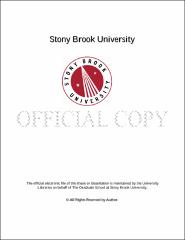| dc.identifier.uri | http://hdl.handle.net/11401/76361 | |
| dc.description.sponsorship | This work is sponsored by the Stony Brook University Graduate School in compliance with the requirements for completion of degree. | en_US |
| dc.format | Monograph | |
| dc.format.medium | Electronic Resource | en_US |
| dc.language.iso | en_US | |
| dc.publisher | The Graduate School, Stony Brook University: Stony Brook, NY. | |
| dc.type | Thesis | |
| dcterms.abstract | Bone is one of the most vital organs in animals, serving as both structural and protective functions. Remodeling of bone is an important indicator of bone health, and disorders in bone remodeling may lead to bone diseases such as osteoporosis. Osteoporosis increases risk of bone fracture and even death, and much more preferable to be happened in postmenopausal women due to great changes in hormones. Micronutrients, such as Zinc (Zn) and Iron (Fe), would as well influence bone health in different manners. That Zn would promote bone health is widely accepted, for the reasons Zn increases osteoblast cell proliferation and differentiation, inhibits osteoclast cell activities, and forms alkaline phosphatase that does help to maintain bone metabolism. Diseases caused by Fe overload is usually related to osteoporosis. Ferric ion could facilitate osteoclast differentiation, inhibit osteoblast and alkaline phosphatase activities, and interfere with hydroxyapatite crystal growth and depositions. However, changes of concentrations and distributions for Zn and Fe in osteoporotic bones are seldom studied. In this thesis, ovariectomized rat femur bones are used as a model of postmenopausal osteoporosis. Rats from different ages and health conditions are categorized as 6 AM (6-month age matched control), 6 OVX (6-month ovariectomized control), 12 AM (12-month age matched control), 12 OVX (12-month ovariectomized control). The trace elements Zn and Fe is studied through Synchrotron Radiation X-Ray Fluorescence (SRXRF). Elemental maps are used to observe changes in distribution, and further quantitative analysis is used to discover changes in concentration among different animal groups. Both the decrease of Zn and the increase of Fe are significant from healthy to osteoporotic bones (p<0.05). In the meanwhile, accumulation of Zn (p<0.05) and Fe (p>0.1) is also observed over age in healthy groups. Both elements show changes in distribution, that healthy animals present a more even distribution while in OVX groups the tendency of aggregation is observed. These results agree with most of the predictions and add evidence for effects of Zn and Fe on bone health. Hypothesis is further made to rationalize the changing trend observed and explain mechanisms behind. | |
| dcterms.available | 2017-09-20T16:50:06Z | |
| dcterms.contributor | Venkatesh, T.A. | en_US |
| dcterms.contributor | Judex, Stefan. | en_US |
| dcterms.contributor | Meng, Yizhi | en_US |
| dcterms.creator | Yan, Danhua | |
| dcterms.dateAccepted | 2017-09-20T16:50:06Z | |
| dcterms.dateSubmitted | 2017-09-20T16:50:06Z | |
| dcterms.description | Department of Materials Science and Engineering. | en_US |
| dcterms.extent | 52 pg. | en_US |
| dcterms.format | Monograph | |
| dcterms.format | Application/PDF | en_US |
| dcterms.identifier | http://hdl.handle.net/11401/76361 | |
| dcterms.issued | 2014-12-01 | |
| dcterms.language | en_US | |
| dcterms.provenance | Made available in DSpace on 2017-09-20T16:50:06Z (GMT). No. of bitstreams: 1
Yan_grad.sunysb_0771M_11812.pdf: 4444991 bytes, checksum: 1579800d52dae22da7c8e9ef68da285e (MD5)
Previous issue date: 1 | en |
| dcterms.publisher | The Graduate School, Stony Brook University: Stony Brook, NY. | |
| dcterms.subject | Biomedical engineering | |
| dcterms.subject | Bone Health, Iron, Osteoporosis, XRF, Zinc | |
| dcterms.title | Roles of Zinc and Iron on Bone Health in a Rat Model of Osteoporosis | |
| dcterms.type | Thesis | |

